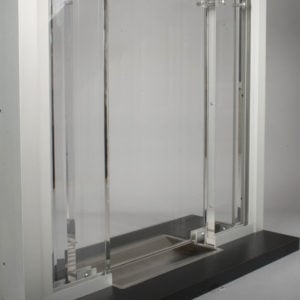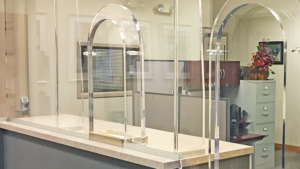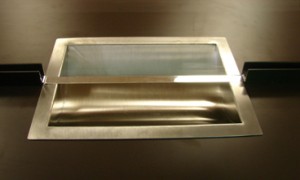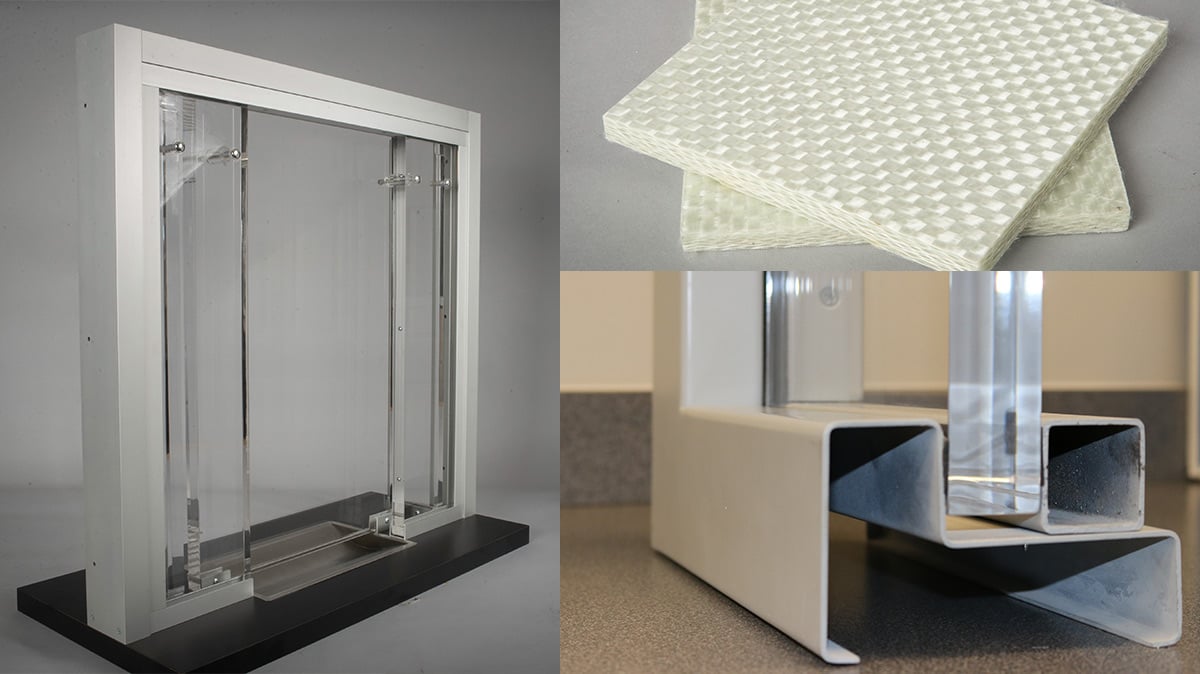You have five key considerations when looking at bulletproof materials and components in order to secure a small office setting:
- Windows
- Walls and Counters
- Communication
- Package Passers/Receivers
- Doors
Although there is an intimidatingly broad array of options, almost every small office environment is well served by just a few easy choices.
The one wild card: Doors. Some offices are laid out so that a bullet-resistant door is optional (or even unnecessary). But in others, that door is your first—and best—line of defense.
Bullet-Resistant Office Windows
Bullet-resistant windows offer the most options which can make them the most daunting part of the job. More bulletproof ideas to incorporate into your small office can be found here.
What you need to know: Almost every office chooses Level 3 LP-1250 interior windows. In addition to stopping bullets, it also carries a forced-entry rating, and even has some inherent blast-resistant qualities. (i.e., in addition to easily stopping every sort of handgun, LP-1250 windows also offer some protection against explosions, extreme weather, vandalism, and looting.) Because LP-1250 is polycarbonate (a dense plastic), it won’t usually chip when shot, and doesn’t tend to let bullets ricochet.
Bulletproof Materials for Walls and Counters
This is often the most neglected part of a bullet-resistant security plan. When threatened, most people will “take cover,” either by dropping down beneath the level of the counter or ducking behind walls. In military parlance, this is called “concealment” because it makes you more difficult to target. It is not true “cover,” because drywall and particleboard will not stop bullets. Bullet-resistant fiberglass is a cost-effective way to transform your counters and walls into true cover, offering excellent protection in an emergency.
Download our infographic to learn more about the 8 Levels of Bullet Resistance
Safe Communications
During the normal workday, you need to be able to hear visitors, and they need to be able to hear you. Modern interior ballistic systems accomplish this in a variety of ways. The most popular communication approach for small offices is a “baffle system,” like the one shown below.

“baffle”-style bulletproof window configuration
These are cost-effective, have excellent voice transmission, and offer the added bonus of clear sightlines (which make it easier to connect with visitors and easier to see trouble coming). Alternately, many small offices opt for “arched” windows like these:

“arch”-style bulletproof window configuration
Package Passers/Receivers
Every office needs to accept or distribute documents. For most settings, a standard recessed “deal tray” (like those used at a stadium ticket counter) is sufficient. There are several styles available, as well as custom options, in either rated or non-rated varieties.

bulletproof materials: the standard deal tray
If your office handles large files, odd-sized packages (such as rolled blueprints), or accepts many deliveries throughout the day, you may also want a package receiver/passer. This guide walks you through those options, and how to choose one that will work for you.
Bullet Resistant Doors
Not every office needs bullet-resistant doors, but it’s worth considering. Walk into your office and try to see the space as someone intent on doing harm might. If there’s a bullet-resistant barrier protecting the front office staff, and a standard hollow-core interior door right next to the bulletproof windows—that’s a pretty obvious target.
For offices with a lower volume of foot traffic, it might make the most sense to invest in an exterior bullet-resistant door with buzz-thru access control, so you can vet visitors using an audio/video intercom system. Since all Total Security Solutions doors (even the “standard” ones) are custom-built at our facility, any door can be shipped ready to accommodate whatever access control system you prefer.
A Quick Reminder: Nothing is “Bulletproof”
No material or component is truly bulletproof.
“Bulletproof” is a colloquial term. People use it for everything from reliable engines to coffee-based diets. Ballistic building materials are bullet-resistant. They are lab tested against the UL 752 “Standard for Bullet-Resisting Equipment.” A given “bulletproof material” or component is rated 1 through 8. In broad terms, materials rated Levels 3 and below stop bullets fired from pistols, while those rated Levels 4 and above stop bullets from rifles or pistols.
Thinking About Your Budget for Bulletproof Materials and Components
A bullet-resistant barrier project is expensive. For example, a bullet-resistant door is usually two to three times more expensive than the equivalent non-bullet-resistant fire-rated door. Bullet-resistant windows and framing are similarly priced.
It isn’t just that the raw bulletproof materials cost more than conventional building materials (although they do). It’s also a practical matter: bulletproof materials are denser and harder. Fabricating them takes more time, greater expertise, and more robust tools.
That said, we recognize that most of you aren’t comparing the price of a bullet-resistant door to the price of a hollow-core door from the big box store. You’re comparing the price of that door to the value of a human life.
Nonetheless, we recognize that everyone has to live within a real—not an ideal—budget.
TSS can offer some very cost-effective physical security options. For example, if you have certain aesthetic needs and can tolerate a slightly lower security level, you might opt for Level 1 or 2 acrylic instead. This is a “brighter” window material and lends itself to extremely attractive installations. We’ve also expanded into new product lines, like Defender Insulated Glass, that offer the security performance many offices need at a great value.
As you begin to plan your project, weigh your risks. What threats do your community, organization, and employees face? How likely is each threat? Finally, how exposed do those threats make you and your staff feel? This sense of exposure is a “soft cost” that is hard to calculate but has an outsized impact because it is cumulative. Meanwhile, improving physical security is a one-time cost. If done right, the benefits of that investment similarly accrue over time.


